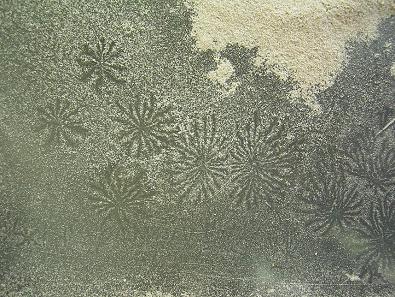Are the Ridge-Troughs at Palisade Colorado entirely natural features or a combination of factors?
The purpose of this page is to present that; human activity contributed
it's affect on natural processes, combining as 'the real causes' for ridge-troughs
The photos at this directory will begin to show the active usage of this area by off-road vehicle enthusiasts and hikers.
The specific trail sequence is in this directory.
You can see videos of motocross
activity at another site called Skinny Ridge which is somewhere near New Castle Co.
Consideration of their effect on the terrain and the resultant channeling of water down the hip-ridge troughs must be factored into any proposal of features and it may apply to the Palisade/GJ location, but there is other traffic, in abundance, to recognize. Foot trails can be followed directly to the ridge area photographed by the TPOD author. Satellite photos barely show the connection with the main trail. It is not the frequented trail but the connection to the main trail can be seen. This opens a factor relevant to a certain detail which captured the tpod author's attention, which he identified as crater chains, but there is another more plausible explanation, that the regrowth of plants within the ridge troughs and the resultant turbulence (eddy) effect is causing alcove erosion. This highlights the need for outward consideration of all mechanisms involved, whether it be human caused or the human influence on natural processes,--
--to do otherwise could result in accusations of pseudo-science coming out of the Thunderbolts Project participants.
In all fairness the idea of troughs being formed by an electrical cause is not unrealistic, for some clues from experiments reveal that electric discharges can cause troughs or negative-relief features, but i have yet to see them along a hip-ridge. I have, however seen them form by vibrations, see the next paragraph. As for electrically caused troughs, i've seen them associated with Spider-looking features in a
number of similar forms, and as trenches and branching channels.


A single discharges to a
simulated ridge is responsible for parallel grooves with branching legs somewhat perpendicular to the ridge. But, they can also result in "ruffles", an accumulation of material at the discharge pathway, creating parallel ridges and valleys.
So, we must proceed cautiously in the assignment of cause on a dynamic planet with many forces and processes at work.
Vibrations combined with gravity will cause parallel grooves on a slope but these grooves 'are' the valley's,
with the exception of one ridge which looks to have a trough along it. (Left 1/3rd about 1/2 way up).

There are actually several spots which could have looked like a ridge trough, but at those, rifting of the ridge has become too far advanced and slumping has occurred. Note that the identified trough is at a ridge which has become less pointed while other ridges remain quite pointed. Where a ridge has slumped at one location a loop has been formed which returns to the parent ridge. The locked valley may be where a rift had been and a trough once morphed into a rift.
This characteristic can be seen at the Skinny-Ridge video's location.
The article associated with the area of the image below is not about electric discharges, it proposes the effects of electric fields focused at ridges and influencing water movement. The focus effect may have some validity from an electrical perspective. Through the CRT experiments i've learned that placing an object on the CRT screen enhanced the discharge potential local to its area of placement. The presence of an influential field along the ridge may be valid but the presence of hip-ridge troughs should be evaluated in consideration of human usage of the area and that influence upon drainage before launching into assigning an electrical cause as the solely responsible for trough formation.

Beware of the monocular photo view and telescopic compression of horizontal features, making vertical features seem more extreme .